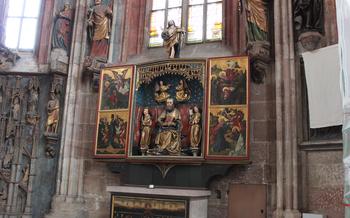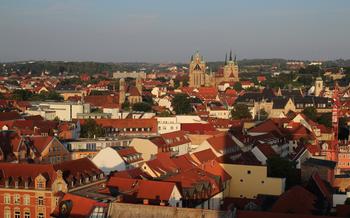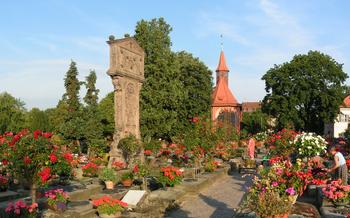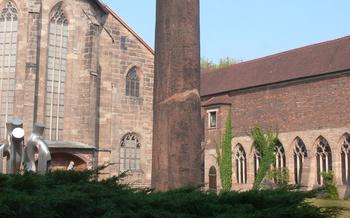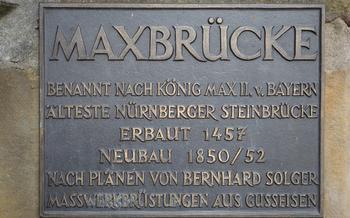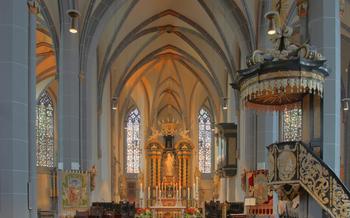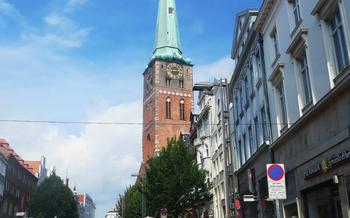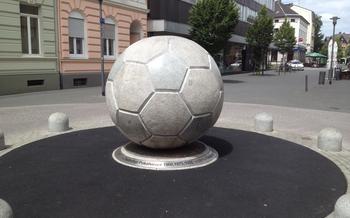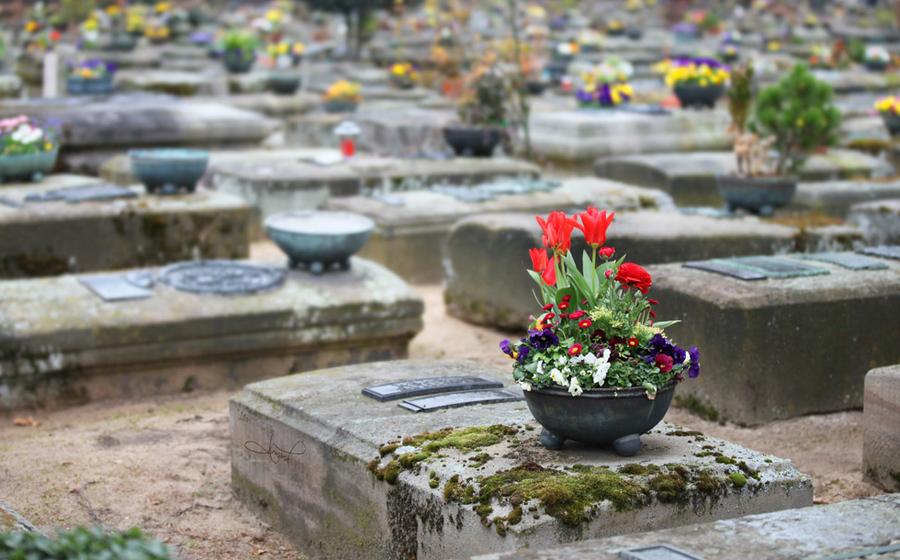
St. Rochus Cemetery (Rochusfriedhof)
- Of History and Tranquility
- A Stroll Through Time: Exploring the Cemetery Grounds
- Honoring the Departed: Notable Burials and Their Stories
- The Art of Remembrance: Sculptures and Memorials
- A Sanctuary for Nature and Wildlife
- Cultural Significance and Historical Context
- Guided Tours and Educational Programs
- Practical Information for Visitors
- Respect and Etiquette: Visiting Guidelines
- Photography and Documentation: Capturing Memories
- Preservation and Conservation Efforts
- Events and Commemorations at Rochusfriedhof
- Local Legends and Folklore
- Literary and Artistic Inspiration
- Insider Tip: Hidden Gems and Secret Spots
Of History and Tranquility
In the heart of Nuremberg, tucked away from the bustling city streets, lies a sanctuary of history and tranquility – the St. Rochus Cemetery (Rochusfriedhof). Established in the 16th century, this sprawling burial ground has borne witness to centuries of Nuremberg's rich history, emerging as a cultural heritage site of immense significance.
Rochusfriedhof's historical roots are intertwined with the devastating plague that swept through Europe in the 16th century. As the city grappled with the loss of countless lives, the cemetery was established outside the city walls, serving as a final resting place for those who succumbed to the deadly disease.
Over the centuries, Rochusfriedhof evolved into a diverse and captivating landscape, reflecting Nuremberg's cultural and artistic heritage. Its unique features include towering sandstone walls, intricate wrought-iron gates, and a harmonious blend of architectural styles, from Gothic to Renaissance.
Among the notable burials in Rochusfriedhof are figures who have left an indelible mark on Nuremberg's history and beyond. From prominent merchants and craftsmen to renowned artists and scholars, their stories are etched in the elaborate headstones and monuments that adorn their graves.
Rochusfriedhof's enduring significance as a cultural heritage site lies in its ability to capture the essence of Nuremberg's past. It is a place where history, art, and nature converge, offering a glimpse into the city's social, religious, and cultural transformations over the centuries.
A Stroll Through Time: Exploring the Cemetery Grounds
Rochusfriedhof's layout is a testament to its long history and diverse burials. The oldest section, dating back to the 16th century, features simple, unadorned graves, reflecting the sober piety of the Reformation era. In contrast, the 18th-century additions showcase elaborate Baroque and Rococo designs, with intricate carvings and symbolic motifs adorning the headstones. The 19th century brought a more uniform appearance, with standardized plots and headstones arranged in neat rows.
Strolling through the cemetery, one encounters a fascinating array of burial plots. From simple wooden crosses to grand mausoleums, each grave tells a unique story. Some graves are adorned with personal mementos and tokens of affection, while others bear inscriptions that offer glimpses into the lives and beliefs of the deceased. The headstones reveal a diverse range of occupations, social statuses, and religious affiliations, reflecting the rich tapestry of Nuremberg's history.
Symbolism and iconography are woven into the fabric of Rochusfriedhof. Angels, cherubs, and biblical figures adorn many of the graves, representing the Christian faith and the hope of resurrection. Skulls, hourglasses, and other memento mori motifs serve as reminders of the transience of life. Flowers, wreaths, and other natural elements add a touch of beauty and symbolism to the gravesites.
Over the centuries, Rochusfriedhof has undergone several changes and additions. In the 19th century, the cemetery was expanded to accommodate the growing population of Nuremberg. New sections were added, including a dedicated area for non-Christian burials. The cemetery also underwent restoration and renovation efforts, ensuring its preservation for future generations.
Honoring the Departed: Notable Burials and Their Stories
Rochusfriedhof is the final resting place of numerous notable figures who have played significant roles in Nuremberg's history and beyond. Among them lies Albrecht Dürer, the renowned Renaissance artist whose intricate engravings and paintings continue to captivate art enthusiasts worldwide. His grave, marked by a simple yet elegant tombstone, serves as a testament to his enduring legacy.
Another prominent figure interred at Rochusfriedhof is Veit Stoss, a sculptor whose exquisite wood carvings adorn many churches and public buildings in Nuremberg. His most famous work, the "Annunciation," is a masterpiece of Gothic art and a testament to his exceptional craftsmanship. His grave, adorned with one of his own sculptures, stands as a tribute to his artistic genius.
The cemetery also holds the remains of Willibald Pirckheimer, a humanist scholar, and close friend of Albrecht Dürer. Pirckheimer's contributions to the intellectual and cultural life of Nuremberg were immense, and his grave serves as a reminder of his erudition and influence.
These are just a few of the many notable individuals laid to rest in Rochusfriedhof. Their stories, achievements, and legacies are intricately woven into the fabric of Nuremberg's history. Visiting their graves offers visitors a chance to pay respects and gain insights into the lives of those who have shaped the city's rich cultural heritage.
The Art of Remembrance: Sculptures and Memorials
Throughout Rochusfriedhof, visitors can admire a remarkable collection of sculptures and memorials that pay tribute to the deceased and add to the cemetery's artistic significance. These works of art range from elaborate statues and intricate carvings to simple yet poignant headstones, each with its own story to tell.
Some of the most striking sculptures are the life-sized figures that seem to emerge from the graves, capturing the essence of the individuals they represent. Angels, cherubs, and saints adorn many of the tombs, symbolizing the transition from earthly life to the afterlife. Other sculptures depict scenes from the Bible or mythology, offering a glimpse into the beliefs and values of the deceased and their families.
One particularly touching memorial is the "Pieta," a sculpture of Mary cradling the body of her son, Jesus. The exquisite detail and emotional depth of this work evoke a sense of compassion and sorrow, reminding visitors of the profound loss experienced by those who have lost loved ones.
The cemetery is also home to a number of war memorials, honoring those who sacrificed their lives in conflicts throughout history. These memorials often feature poignant inscriptions and symbolic imagery, paying tribute to the courage and sacrifice of the fallen.
Beyond the individual sculptures and memorials, the cemetery itself can be seen as a collective work of art. The harmonious arrangement of the graves, the interplay of light and shadow, and the overall atmosphere of tranquility create a unique and moving experience for visitors.
Rochusfriedhof is not just a place of remembrance but also a treasure trove of artistic expression. The sculptures and memorials that adorn its grounds are a testament to the skill and creativity of the artists who created them, and they add immeasurable value to the cemetery's cultural heritage.
A Sanctuary for Nature and Wildlife
Beyond its historical significance, Rochusfriedhof serves as an unexpected haven for nature and wildlife. The cemetery's sprawling grounds encompass tranquil green spaces, inviting diverse flora and fauna to thrive within its tranquil embrace. Visitors can stroll through serene paths lined with towering trees, their branches casting dappled shadows on the ancient graves. The gentle rustle of leaves creates a soothing symphony, adding to the contemplative atmosphere of the cemetery.
The diverse plant life found in Rochusfriedhof contributes to its ecological importance. Colorful flowers bloom in profusion during the spring and summer months, adding vibrant hues to the historic landscape. These flowers not only beautify the cemetery but also attract a variety of pollinators, such as bees and butterflies, contributing to the delicate balance of the ecosystem.
Rochusfriedhof is also home to a variety of wildlife, including birds, small mammals, and insects. Squirrels scamper through the trees, their playful antics adding a touch of life to the solemn surroundings. Birdsong fills the air, creating a harmonious chorus that echoes through the cemetery's hallowed halls. The cemetery's quiet corners provide shelter for nesting birds, allowing them to raise their young in relative peace.
The presence of nature within Rochusfriedhof creates a unique juxtaposition between the tranquility of death and the vibrancy of life. Visitors can find solace and inspiration amidst the beauty of the natural world, as the cemetery transforms into an urban oasis that fosters biodiversity and ecological resilience.
Cultural Significance and Historical Context
Rochusfriedhof stands as a testament to Nuremberg's rich and multifaceted history. It mirrors the city's social, religious, and cultural transformations over the centuries. Each burial plot, headstone, and memorial tells a story, offering glimpses into the lives, beliefs, and traditions of Nuremberg's past residents.
The cemetery's layout and design reflect the city's changing urban landscape. In its early days, the cemetery was situated outside the city walls, reflecting the medieval belief in separating the living from the dead. As Nuremberg expanded, the cemetery became engulfed by the city's growth, becoming an integral part of its urban fabric.
The diversity of burial plots and headstones in Rochusfriedhof speaks to the city's social and cultural diversity. Elaborate family tombs and mausoleums stand alongside simpler graves, reflecting the different social classes and economic backgrounds of those buried here. The headstones bear witness to the changing artistic styles and tastes of each era, from Gothic to Renaissance to Baroque and beyond.
The cemetery also offers insights into Nuremberg's religious history. The presence of both Protestant and Catholic sections reflects the city's religious divisions during the Reformation. The inclusion of Jewish graves, though modest in number, highlights the city's once-thriving Jewish community.
Through its burials, monuments, and symbolism, Rochusfriedhof provides a tangible link to Nuremberg's past, allowing visitors to explore the city's history and culture in a unique and evocative setting.
Guided Tours and Educational Programs
Rochusfriedhof offers a range of guided tours and educational programs that provide visitors with deeper insights into the cemetery's history, art, and symbolism. These tours are led by knowledgeable guides who share fascinating stories and anecdotes about the notable burials, sculptures, and cultural significance of the site.
A popular tour option is the "History and Art Walk," which takes visitors on a journey through time, exploring the cemetery's origins, architectural features, and the lives of some of its most famous residents. The tour highlights the unique symbolism and iconography found on the graves, shedding light on the social, religious, and cultural context of the era.
For those interested in a more in-depth exploration, themed tours are available, focusing on specific aspects of the cemetery. These tours may delve into the lives of prominent artists, musicians, or historical figures buried in Rochusfriedhof, or examine the cemetery's role in reflecting Nuremberg's rich past.
Educational programs are also offered, catering to students, researchers, and history enthusiasts. These programs provide a structured learning experience, exploring topics such as funerary art, cultural heritage conservation, and the impact of death and mourning on society.
Participating in guided tours and educational programs is a rewarding way to enhance your visit to Rochusfriedhof. These programs offer a unique opportunity to learn from experts, gain a deeper understanding of the cemetery's significance, and appreciate its beauty and history in a new light.
Practical Information for Visitors
Location and Accessibility
Rochusfriedhof is conveniently located in the Gostenhof district of Nuremberg, within easy reach of the city center. Visitors can take public transportation, such as the U1 subway line or various bus routes, to get to the cemetery. The closest U-Bahn station is Rochusfriedhof, situated right next to the cemetery entrance. For those arriving by car, there is limited street parking available in the surrounding streets.
Opening Hours and Admission Fees
Rochusfriedhof is open to the public daily from 8 am to 6 pm, allowing visitors to explore its serene grounds at their convenience. Admission to the cemetery is free of charge, making it an accessible and affordable attraction for everyone.
Facilities and Amenities
Visitors to Rochusfriedhof will find several amenities to enhance their experience. Public restrooms are available within the cemetery grounds for convenience. Benches and seating areas are scattered throughout the cemetery, providing opportunities to rest and contemplate the tranquil surroundings. Additionally, there are informational signs and brochures available to help visitors learn more about the history and notable burials of Rochusfriedhof.
Tips for Planning a Visit
To make the most of your visit to Rochusfriedhof, consider the following tips:
- Plan your visit during the warmer months to fully appreciate the lush greenery and vibrant colors of the cemetery.
- Wear comfortable shoes, as you will be doing a lot of walking on uneven terrain.
- Bring a camera to capture the beauty of the sculptures, monuments, and headstones.
- Respect the privacy of the deceased and their families by maintaining a respectful demeanor and tone of voice.
- Be mindful of the cemetery's rules and regulations, such as no pets allowed and no picnicking or loud talking.
Respect and Etiquette: Visiting Guidelines
Rochusfriedhof, like any cemetery, is a place of reverence and remembrance. Visitors are expected to conduct themselves in a respectful and considerate manner. Proper attire is essential, with modest clothing and covered shoulders being the norm.
Silence is observed within the cemetery grounds, allowing visitors to reflect and connect with the serene atmosphere. Refraining from loud conversations, laughter, or any behavior that may disturb the peace is essential.
Respecting the privacy of the deceased is of utmost importance. Avoid touching or leaning on tombstones or memorials, as they are personal spaces for remembrance.
Photography is permitted, but it should be done with discretion and respect. Refrain from using flash or taking photographs that may be intrusive or disrespectful to those grieving or visiting the graves of loved ones.
Remember that Rochusfriedhof is an active burial ground, and visitors may encounter mourners or individuals paying their respects. Be mindful of their grief and offer them the space and privacy they need.
By following these guidelines, visitors can contribute to the preservation of the cemetery's sacred atmosphere and ensure a respectful and meaningful experience for all.
Photography and Documentation: Capturing Memories
Rochusfriedhof offers opportunities for visitors to capture the beauty and solemnity of the cemetery through photography. While preserving memories and documenting the cemetery's heritage are encouraged, it's essential to do so respectfully.
Respect for the Deceased:
- Always prioritize the privacy and dignity of the deceased when taking photographs.
- Avoid photographing individuals or graves without permission.
- Be mindful of mourners or visitors who may be grieving or paying respects.
Ethical Considerations:
- Strive to capture the essence of the cemetery without sensationalizing or exploiting its history or symbolism.
- Consider the impact of your photographs on the families and descendants of those buried in the cemetery.
- Obtain permission if you intend to use photographs for commercial purposes or public display.
Composition and Framing:
- Experiment with different angles and perspectives to capture the unique features of the cemetery.
- Utilize natural light to enhance the mood and atmosphere of your photographs.
- Pay attention to composition and framing to create visually appealing and meaningful images.
Capturing Details:
- Focus on specific elements such as sculptures, headstones, or architectural details to showcase the intricate artistry and symbolism.
- Capture the interplay of light and shadow, which can add depth and drama to your photographs.
- Experiment with different lenses and techniques to capture both wide-angle shots and close-up details.
Respecting the Sanctity:
- Remember that Rochusfriedhof is an active burial ground and a place of remembrance.
- Be mindful of your behavior and actions while taking photographs.
- Avoid disturbing or damaging the graves, sculptures, or other elements of the cemetery.
Preserving Memories:
- Documenting the cemetery through photography can contribute to its preservation and historical record.
- Share your photographs responsibly, ensuring they are accompanied by accurate captions and respect for the individuals and stories they depict.
Preservation and Conservation Efforts
The passage of time and various environmental factors can take their toll on any historical site, and Rochusfriedhof is no exception. To ensure its preservation for future generations, ongoing conservation and restoration initiatives are crucial. These efforts require meticulous attention to detail and a deep understanding of the cemetery's unique characteristics.
The cemetery's administration works closely with experts in conservation and restoration to address the challenges posed by weathering, pollution, and natural deterioration. Historic materials and techniques are carefully employed to maintain the authenticity of the site.
Moreover, the cemetery relies on the support of visitors to contribute to its preservation. By adhering to guidelines and respecting the fragile nature of the site, visitors can help protect its heritage. Avoiding touching or leaning on structures, and refraining from leaving behind any litter, are simple yet effective ways to contribute to the preservation efforts.
By working together, the cemetery's administration, experts, and visitors can ensure that Rochusfriedhof continues to stand as a testament to Nuremberg's rich history and cultural significance, for generations to come.
Events and Commemorations at Rochusfriedhof
Rochusfriedhof serves as a poignant backdrop for various events and commemorations that honor the departed and celebrate the cemetery's rich history. These events provide opportunities for visitors to engage with the cemetery's cultural and historical significance beyond a casual visit.
One of the most notable events is the annual Reformation Day Commemoration, held on October 31st. This solemn ceremony pays tribute to the Protestant Reformation, which began in Nuremberg in 151Visitors can witness a reenactment of Martin Luther's famous act of defiance, when he nailed his 95 theses to the door of the nearby St. Sebaldus Church.
Another significant event is the All Souls' Day Commemoration, observed on November 2nd. During this day of remembrance, families gather at the cemetery to honor their deceased loved ones. The cemetery is illuminated with thousands of candles, creating a deeply moving and contemplative atmosphere.
In addition to these major events, Rochusfriedhof also hosts occasional concerts, art exhibitions, and historical lectures. These events allow visitors to experience the cemetery from a different perspective, appreciating its cultural and artistic significance.
By participating in these events and commemorations, visitors can gain a deeper understanding of Nuremberg's history and the cultural significance of Rochusfriedhof. These events offer a unique opportunity to connect with the past and honor the memory of those who have shaped the city's rich heritage.
Local Legends and Folklore
Rochusfriedhof is steeped in mystery and folklore, adding an air of intrigue to its tranquil atmosphere. Local legends and tales have been passed down through generations, weaving a tapestry of supernatural encounters and ghostly apparitions. Visitors may sense an otherworldly presence as they wander through the ancient paths, surrounded by centuries-old gravestones and ornate sculptures.
One of the most enduring legends is that of the "White Lady," a spectral figure said to roam the cemetery at night. Some believe she is the spirit of a young woman who died tragically and now seeks solace among the graves. Others whisper that she is a guardian of the cemetery, ensuring that the souls of the departed rest in peace.
Another eerie tale tells of a phantom carriage that is sometimes seen gliding through the cemetery grounds. Drawn by ghostly horses and driven by a mysterious figure, it is said to carry the spirits of those who have passed away.
These legends and stories add a sense of enchantment to Rochusfriedhof, inviting visitors to delve into the realm of the supernatural. While the existence of ghosts remains a matter of belief, the cemetery's eerie atmosphere and captivating history create an ideal setting for tales of mystery and wonder.
Literary and Artistic Inspiration
Rochusfriedhof's distinctive atmosphere and intriguing history have served as a muse for numerous literary, artistic, and musical endeavors. The cemetery's serene beauty, poignant stories, and evocative symbolism have captivated the imaginations of writers, artists, and musicians, inspiring them to create works that explore themes of mortality, remembrance, and the human condition.
One notable example is the 19th-century German poet Friedrich Rückert, who found inspiration for his poignant poems in the cemetery's melancholic atmosphere. His works, such as "Auf dem Kirchhofe" ("In the Graveyard"), reflect on the transient nature of life and the enduring power of memory.
The cemetery's influence extends beyond literature, reaching into the realm of visual arts. In the early 20th century, the Expressionist painter Ernst Ludwig Kirchner created a series of haunting and evocative prints depicting the cemetery's somber landscapes and haunting figures. These works, characterized by their bold colors and distorted forms, capture the emotional intensity and spiritual depth of the site.
Rochusfriedhof's allure has also resonated with musicians. The German composer Max Reger, known for his Romantic and late-Romantic compositions, drew inspiration from the cemetery's tranquil ambiance. His works, such as the organ piece "Präludium und Fuge in c-Moll" ("Prelude and Fugue in C minor"), evoke a sense of solemnity and contemplation, mirroring the spirit of the hallowed ground.
These artistic expressions not only showcase the cultural significance of Rochusfriedhof but also attest to its enduring ability to inspire creativity and provoke contemplation. Visitors to the cemetery can deepen their experience by delving into the literary and artistic works inspired by this unique and evocative space.
Insider Tip: Hidden Gems and Secret Spots
Beyond the well-known attractions, Rochusfriedhof holds hidden gems and secret spots that offer a unique perspective on the cemetery's history and beauty. One such gem is the "Waldfriedhof" (Forest Cemetery), a secluded area within the cemetery dedicated to burials under the shade of towering trees. Here, visitors can find a serene and peaceful atmosphere, surrounded by nature's tranquility.
Another lesser-known feature is the "Ehrenhain" (Honor Grove), a section of the cemetery dedicated to honoring the fallen soldiers of various wars. This somber yet poignant area features rows of simple white crosses, each representing a life lost in defense of the nation.
For those seeking artistic treasures, the hidden corners of Rochusfriedhof reveal exquisite sculptures and monuments that often go unnoticed by casual visitors. Look out for the intricate carvings on the tombstone of the renowned sculptor Johann Leonhard Dill, or the haunting figure of the "Angel of Death" perched atop a grand mausoleum.
By venturing off the beaten path and exploring the hidden corners of Rochusfriedhof, visitors can uncover the cemetery's untold stories and experience its unique atmosphere more profoundly. Embrace the spirit of discovery, let curiosity be your guide, and uncover the secrets that lie within this historic resting ground.
